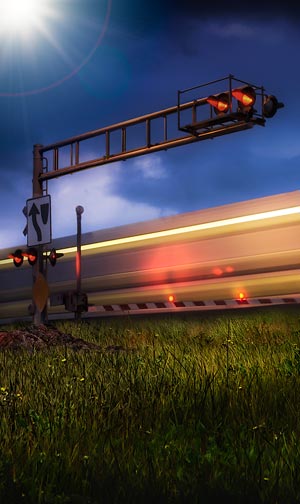In the ideal world, railroad tracks and roads would never cross, but that is practically impossible. Because trains and motor vehicles must occasionally cross paths, train crossing signals are necessary to avoid collisions. By some estimates, there are more than 200,000 grade crossings in the United States, and crossing signals are a common sight. But how do they work? And what happens if there is a defect that prevents necessary warnings from being given? A railroad crossing accident lawyer takes a deeper look.
Visual and Audible Warnings
Some of the most common components of grade crossing signals are:
- Red flashing lights
- Gates create barriers that drop across traffic lanes
These signals should start well before the train approaches the road. That means the signals need to detect an approaching train, so the lights can start flashing and the arms drop before anyone gets onto the tracks and is injured.
However, the gates or arms can’t drop too quickly, because vehicles need enough time to clear the tracks. Proper timing is critical when it comes to railroad crossings.
The Technology Behind Train Crossing Signals
Modern signals take advantage of the steel train wheels and rails. A circuit will run up one rail and back down the other. When a train arrives, it creates a short circuit, which triggers any connected warning devices. In other words, the train’s arrival is what causes the warnings. There is no need for the conductor to flip a switch or take any other action.
Providing sufficient warning time is critical. As explained by Union Pacific, modern crossings use “constant warning” technology, which adjusts to the speed of the oncoming train. This means that the same amount of warning will be given whether the train is going slowly or racing down the tracks.
Did Warnings Fail?
Like all technology, train crossing signals need regular inspection, maintenance, and possible upgrades to protect public safety. Unfortunately, many track owners or trains are negligent in identifying, repairing, or replacing crossing signals. When that happens, motorists will receive no warning other than the horn that the conductor should sound as the train enters the crossing.
In some areas of the country, other obstacles will prevent the smooth functioning of warning signals. Tree branches or shrubbery could obscure the view of the railway, or overgrown branches might literally block the arms from coming down.
Speak with an Attorney about Your Accident
Pottroff & Karlin, LLC, is one of the leading law firms in the entire nation dedicated to railway accidents. These are unusual accidents, and not all personal injury lawyers can adequately handle a victim’s claim. Our firm has the experience and skill that victims need after a devastating crash and injuries. Contact us to set up a free consultation at a convenient time.


